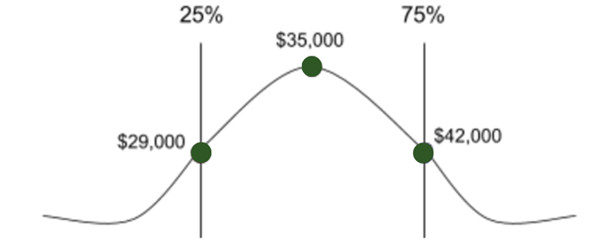After the Interview
How to Negotiate Your Salary
Congratulations! If you’re reading this, you’ve probably received a job offer or are anticipating one soon. Salary negotiation is an important (if not THE most important) piece in the job offer stage. Follow these three steps to effectively negotiate your salary or view this printable infographic.
Step 1: Look at the job description and identify what skills and experiences you have that are relevant to the position. These will help you justify your request for a salary increase. The more skills that match the job description, the more justification you have to negotiate a higher salary! If you have additional skills or more experience not mentioned in the job description that could be useful for the position, that would be good to emphasize as well.

Step 2: Research the average salary for your position using the websites below. Be sure you are comparing jobs of similar functions and in the same geographic location.
Salary.com - Employer supplied data regarding employee salaries
Glassdoor - Employee supplied data regarding employee salaries
How Much - Salary calculator for cost of living, broken down to city regions

Once you’ve identified the average salary (ex: $35,000) for the type of position and region, identify your target salary based on your experience and skills that are relevant to the position. The more skills and experience that matches or exceeds what the job description lists, the higher your target salary can be. Once you’ve identified a target salary amount (ex: $37,000), determine a Bolstering Range. Use the bolstering range instead of your target salary when telling the employer how much you are hoping to be paid. This range is anchored on the low end by your target salary and then can go up to 20% maximum for the range. Telling the employer a salary range is better than a specific amount as it gives both you and the employer some leeway in the negotiation.

The Resistance Point shown on the image above is the lowest salary you will take. It is important to know this so that you know when to push back in a negotiation.
Step 3: Identify which benefits you are wanting to negotiate in addition to your salary. Benefits such as health insurance, flexible hours, retirement, vacation time, relocation expenses, hiring bonus, etc. can also be negotiated. This is important to remember as employers may be willing to negotiate a better parking spot or flexible hours to offset not being able to pay your targeted salary. Create a prioritized list of the salary and benefits you desire to negotiate, and practice speaking your planned negotiation out loud. Identify multiple ways that you can be told no in each step of your negotiation and develop persuasive responses.
Quick Tips
- Don’t name a salary first; instead deflect.
- Utilize ‘we’ language and remain positive/flexible.
- Get everything in writing at both the beginning and end.
- Trust your gut. If you feel like the employer is unhappy that you’re continuing to negotiate, trust your instincts.
- I interviewed for [job title] at [company/type of company]. We talked about [describe what you talked about in the interview]. What should I write in my thank-you note to my interviewer who is [role of interviewer]?
- I interviewed for [job title] at [company/type of company], and I’m planning to send a thank-you note to [role of interviewer]. Here’s what I’ve written: [thank-you note draft]. Do you have feedback on how I could write this better?
- I interviewed for [job title] at [company/type of company], and I have a follow-up question for my interviewer. How can I ask it in a follow-up email?
- Write a thank you email to an interviewer. Reference (something you discussed).
AI-generated content is intended to be informative and helpful; however, it should not be considered as professional advice or a substitute for consulting with qualified experts in career services. We encourage users to independently verify and cross-reference the information provided by the AI model with other reliable sources before making any decisions or taking any actions based on the content. The AI-generated content should be used as a draft for written documents and a starting point for career research and exploration, but it is essential to exercise critical thinking and judgment when editing, interpreting and applying the information for your own career or job search needs.
Receive in-person assistance in our walk-up Career Studio after taking the first steps with AI.
After being granted an opportunity to be hired, to learn, or generally be helped,
writing a thank you card is appropriate. Thank you cards can be send via post or email,
depending on the situation.
Template:
Dear [Person you are thanking],
[Thank the person for the their time and support. Reference something specific you
spoke about with them, such as a piece of advice or information that you found helpful
or interesting and how you will implement it (if applicable). Mention your enthusiasm
for the field or position if relevant.]
[Express a willingness to help them in the future.]
Sincerely,
[Your name]


